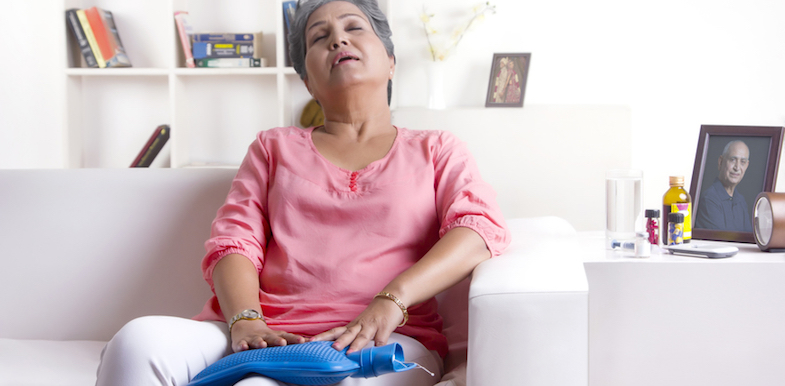Chronic Pain
When a person is injured, a certain period of pain is to be expected. Pain can be a helpful way for the body to limit activity and ask for rest. However, sometimes pain lasts longer than is necessary for healing, moving quickly from becoming an acute, protective response to a long-term, chronic condition. For the approximately 100 million people in the U.S suffering from chronic pain, many of them with no outward injury, this condition affects all aspects of daily life. Here’s what you should know about this condition.
What is chronic pain?
While acute pain alerts you to an injury and typically lasts for 30 days or less, chronic pain lasts for longer than three months. Or, for a simpler approach, chronic pain is any type of pain that lasts longer than is reasonably expected for the injury.
This type of pain does not have one single characteristic. It can be mild, moderate, or severe. It can be unceasing or sporadic. Further, it can range in intensity from mildly irritating to severely disabling.
Chronic pain is commonly rooted in musculoskeletal, neurologic, urologic, gastrointestinal, or reproductive disorders. It also has associations with psychological disorders such as major depression, conversion disorder, hypochondriasis, and somatization disorder.
People typically experience pain in the following areas:
Most importantly, chronic pain is a mystery, even among people who study it. Why does one person develop chronic pain from an injury when another with the exact same injury does not? It can be an enigma due to pain’s complicated natural history, vague etiology, and poor response to treatment. There may be an inciting incident (as in acute injury), an ongoing cause of pain (like arthritis), or an absence of both.
While researchers and doctors can make reasonable guesses about pain’s characteristics and how it works in and moves through the body, the human response to pain remains a complex and evolving science.
Major chronic pain causes
Chronic pain takes a toll both physiologically and psychologically. In addition to the pain itself, patients may experience other side effects as a result, including:
- Depression
- Poor sleep
- Decreased libido
- Substance abuse
- Mood issues
- Disability
- Sleep apnea
Most certainly, chronic pain restricts the activities of daily living and decreases the quality of life in those who experience it. It can be a contributor to family or marital problems (with spousal disagreements making the pain worse), and those with chronic pain face higher levels of unemployment and challenging side effects that result from their treatments for pain.
Some primary risk factors include:
- Stress
- Anxiety
- Fatigue
- Depression
- Anger
- Gender (with chronic pain occurring more often in women)
The risk factors may have to do with the inhibition of endorphins, natural pain-relieving (and mood elevating) hormones. Clinical studies have shown that those with chronic pain have lower than normal levels of endorphins in their cerebrospinal fluid (CSF).

Types of chronic pain
There are five general categories of conditions that contribute to the development of this type of long-lasting pain.
- Musculoskeletal
- Neurologic
- Urologic
- Gastrointestinal
- Reproductive disorders
Let’s look at these in more detail.
1. Musculoskeletal disorders
Musculoskeletal disorders are the most common cause of chronic pain. Often, people may have these conditions and recover after the acute phase, but those with chronic pain struggle to find relief.
These conditions include:
- Osteoarthritis
- Rheumatoid arthritis
- Lyme disease
- Disc herniation
- Spinal compression fractures
- Poor posture
- Fibromyalgia
- Muscular strains and sprains
- Hernias
- Chronic overuse syndromes, such as tendinitis and bursitis
2. Neurologic disorders
Neurologic disorders that cause chronic pain generally involve the brain (perhaps in addition to other body systems).
These include:
- Brachial plexus traction injuries
- Spinal stenosis
- Cervical radiculopathy
- Shingles
- Polyneuropathies
- Migraine headaches
- Muscle tension headaches
- Chronic daily headaches
- Temporomandibular joint dysfunction (TMD or TMJ)
- Sinusitis
- Stroke
The most frustrating type of pain is that which cannot be traced to any one cause. Neuritis, or nerve inflammation, is a condition that causes chronic pain with no clear trigger.
3. Urologic disorders
Urologic conditions can occur in some individuals as an acute pain incident (e.g., kidney stones) without becoming chronic, while for others the pain persists.
Common urologic disorders that can lead to chronic pain include:
- Bladder cancer
- Chronic urinary tract infections (UTIs)
- Interstitial cystitis
- Kidney stones
- Prostatitis
- Peyronie disease
- Testicular torsion
- Urethral stricture
4. Gastrointestinal disorders
Many GI disorders come in a flare-up and remission cycle with intervals that vary from person to person. Those associated with chronic pain include:
- Gastroesophageal reflux disease (GERD)
- Peptic ulcer disease (PUD)
- Pancreatitis
- Diverticulitis
- Bowel obstruction
- Colitis
- Chronic constipation
- Inflammatory bowel disease (IBD or IBS)
5. Reproductive disorders
Reproductive disorders that lead to chronic pain are not well understood and lack proper research in terms of funding and time spent on these conditions.
However, some conditions that may contribute include:
- Endometriosis
- Adhesions
- Salpingitis
- Chronic ectopic pregnancy
- Pelvic congestion syndrome
- Fibroids
- Cervical stenosis
- Vulvodynia
- Genital prolapse
There are other pain conditions that defy classification. These include long-lasting pain after injuries, trauma, and infections.
How to diagnose chronic pain
A diagnosis is crucial for proper treatment. Key factors a physician will want to know about when taking your pain history include:
- The location of pain
- The frequency of pain
- Precipitating factors
- Treatments that help with your pain
- Quality of pain
- Radiation of pain
- Intensity of pain
A detailed physical examination is also helpful at pinpointing potential causes of your pain. Imaging studies such as X-ray, computed tomography (CT), and magnetic resonance imaging (MRI) may also be helpful for diagnosis.

Chronic pain treatments that can help
The best treatment for chronic pain is one that takes a multidisciplinary approach that includes coordination between primary care physicians, pain specialists, psychologists, and therapists.
Treatments fall into three general categories:
- Medications
- Procedures or surgeries
- Therapies
1. Medications
Medications are the cornerstone of treating chronic pain. Non-steroidal anti-inflammatory drugs (NSAIDs) that have been used include:
- Ibuprofen (Advil, Motrin)
- Naproxen sodium (Naprosyn, Anaprox)
- Diclofenac (Voltaren, Cataflam XR)
- Indomethacin (Indocin)
- Ketoprofen
These medications act to reduce inflammation, thereby reducing pain.
Even though it is unclear exactly how they work on the brain, antidepressants are also commonly used. These include:
- Tricyclic antidepressants (TCAs) (amitriptyline and nortriptyline)
- Selective serotonin norepinephrine reuptake inhibitors (SNRIs) (duloxetine and venlafaxine)
- Selective serotonin reuptake inhibitors (SSRIs) (fluoxetine, sertraline, and paroxetine)
- Anticonvulsants (gabapentin and pregabalin)
It is important to note that there is no research that supports the long-term use of narcotic analgesics in the treatment of chronic pain. Best prescribed for acute injury, surgery, or end-stage cancer pain, narcotic medications such as oxycodone, hydrocodone, and fentanyl carry more risk of side effects and dependence and can cause more problems than they solve. Additionally, new research has found that they don’t work to relieve pain any better than over-the-counter or non-opioid medications.
2. Procedures and surgeries
Various procedures and surgeries are also available to manage your pain. There are a few common surgeries or procedures that may help when other treatments have been unsuccessful.
- Nerve blocks: This procedure involves injecting an anesthetic and a corticosteroid near nerves that are responsible for chronic pain. These block pain signaling and reduce inflammation.
- Spinal cord stimulation: SCS involves implantation of an electrical device that replaces pain signals with a slight buzzing sensation.
- Intrathecal morphine pumps: This pump is implanted and delivers regular doses of medication.
- Radiofrequency ablation (RFA): RFA is minimally invasive and uses heat to damage nerve tissue (or destroy it altogether), disrupting pain signals.
- Adhesiolysis: Medications can destroy adhesions, or scar tissue, that may be irritating nerve roots and causing pain.
- Vertebroplasty: These next two procedures treat chronic back pain from spinal compression fractures. These fractures occur most often in people with osteoporosis (thinning and weakening of bone). Vertebroplasty requires the injection of special cement into the affected areas of the spine, which restores and straightens the spinal column.
- Kyphoplasty: Kyphoplasty is similar to vertebroplasty and is done by inserting a balloon into the spinal fracture. This creates a cavity into which cement is injected.
- Steroid injections (cervical and epidural): These can also provide long-term relief of pain for some patients. They should not be repeated more than three times in a period of 12 months. You can learn more about this procedure in the following video.
3. Therapies
Many therapies can also be integrated into your treatment plan. In many cases, patients experience more relief from pain when non-traditional therapies are also incorporated in their treatment plan.
The most common therapies include:
- Physical therapy (PT) techniques: These professionals utilize modalities such as hot or cold therapy, stretching, positioning, massage, traction, ultrasound therapy, manipulation, and transcutaneous electrical nerve stimulation (TENS) to manage stretch and strengthen muscles
- Chiropractic manipulation: Can help treat a variety of musculoskeletal conditions, especially those involving the spine
- Occupational therapy (OT): Teaches desensitization techniques and can help with repetitive work pain
- Recreational therapy: Utilizes enjoyable activities that culminate in decreased pain
- Vocational therapy: Can give an idea of work capacity and targeted pain relieving activities
- Psycho-physiologic therapies: These include practices such as counseling, biofeedback, relaxation training, acceptance and commitment therapy (ACT), cognitive behavioral therapy (CBT), and stress management.
- Acupuncture: This practice decreases inflammation, increases the release of endorphins, and can be effective for chronic pain. Types of acupuncture include traditional needle, manual, laser, and electroacupuncture.
References
- Abdi S, Datta S, Trescot AM, Schultz DM, Adlaka R, Atluri SL, Smith HS, Manchikanti L. Epidural steroids in the management of chronic spinal pain: a systematic review. Pain Physician. 2007;10(1):185-212.
- Cheng J, Pope JE, Dalton JE, Cheng O, Bensitel A. Comparative outcomes of cooled versus traditional radiofrequency ablation of the lateral branches for sacroiliac joint pain. Clin J Pain. 2013;29(2):132-137.
- Choi E, Nahm FS, Lee PB. Evaluation of prognostic predictors of percutaneous adhesiolysisusing a Racz catheter for post lumbar surgery syndrome or spinal stenosis. Pain Physician. 2013;16(5):E531-536.
- Garcea G, Thomasset S, Berry DP, Tordoff S. Percutaneous splanchnic nerve radiofrequency ablation for chronic abdominal pain. ANZ J Surg. 2005;75(8):640-644.
- Glazov G, Yelland M, Emery J. Low-dose laser acupuncture for non-specific chronic low back pain: a double-blind randomised controlled trial. Acupunct Med. 2013; in press.
- Goz V, Errico TJ, Weinreb JH, Koehler SM, Hecht AC, Lafage V, Qureshi SA. Vertebroplasty and kyphoplasty: national outcomes and trends in utilization from 2005 through 2010. Spine J. 2013;in press.
- Manchikanti L, Cash KA, McManus CD, Pampati V. Assessment of effectiveness of percutaneous adhesiolysis in managing chronic low back pain secondary to lumbar central spinal canal stenosis. Int J Med Sci. 2013;10(1):50-59.
- Manchikanti L, Cash KA, Pampati V, Wargo BW, Malla Y. Management of chronic pain of cervical disc herniation and radiculitis with fluoroscopic cervical interlaminar epidural injections. Int J Med Sci. 2012;9(6):424-434.
- Von Korff MR. Long-term use of opioids for complex chronic pain. Best Pract Res Clin Rheumatol. 2013;27(5):663-672.
- Wasserman RA, Brummett CM, Goesling J, Tsodikov A, Hassett AL. Characteristics of chronic pain patients who take opioids and persistently report high pain intensity. Reg Anesth Pain Med. 2013; in press.